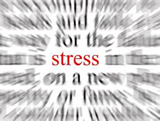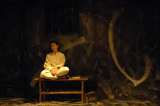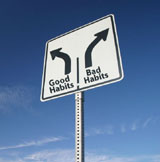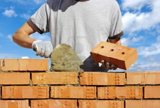Growth
The stress of growth
Abstract
This article examines the relationship between stress and personal growth. The author, based on his own experience, looks at some tendencies which precede this affliction. He discusses and looks at stress from his understanding of Integral Health in the context of the Integral Yoga. He believes that only by integralising the being can this condition become truly resolved. He explains how he tries to do this.
Stress is produced by a wrong response to pressure and leaves a feeling of helplessness. It is interesting to see how it has now taken a new context in my life. Fifteen years ago, in the West, I had felt overburdened with stress, which prompted me to take a decision to leave that life. But the triggers and ways of resolving this affliction are very different now.
My first exposure to stress was characterised by a feeling of mismatch. There was the customary obligation to conform and place myself squarely in the social mix. I had been conditioned to leave a stamp on society but it was never an easy fit. There was always a feeling of friction and abrasion. I somehow burrowed a path but there was a nagging feeling behind that my true calling was not being heeded. A major illness intervened and the doubts increased. But I only proceeded to drive myself onward even faster. And when the time came to earn a living, stress became a constant shadow. In a sense, I often used it to galvanise my energy and I drew nourishment from the vital atmosphere around me. The urge to make an imprint on society became more pronounced. The stressors of responsibility, competition and desire for success became ever-present.
My life then had little orientation inside, so I was largely tossed around by circumstances. However, I believe that there was always a secret hand engineering events towards a truer way. It’s just that I didn’t realise it. So finally I came to India, embarked on the Integral Yoga and moved into a freer and vaster air. I threw myself into a new life and naively anticipated that the problem of stress would get left behind. I believed that I would never again have to be a captive of occurrence. However, in spite of the guidance I receive, the spectre of stress has never completely disappeared. It just makes a comeback in a different guise.
Backdrop
Stress is very evident on a global scale. At present, the world is going through tremendous turmoil; everything is churning. Meanwhile, matter and spirit are gradually joining hands. Two armies of progress and regression are engaged in battle. Back in 1958, the Mother (1) described the scenario very vividly:
“One thing seems obvious, humanity has reached a certain state of general tension — tension in effort, in action, even in daily life — with such an excessive hyperactivity, so widespread a trepidation, that mankind as a whole seems to have come to a point where it must either break through the resistance and emerge into a new consciousness or else fall back into an abyss of darkness and inertia.
“This tension is so complete and so widespread that something obviously has to break. It cannot go on in this way. We may take it as a sure sign of the infusion into matter of a new principle of force, consciousness, power, which by its very pressure is producing this acute state....” (pp. 296-7)
It is quite clear that this sense of tension has not abated. Perhaps the conflict has polarised even more.
The individual
Once I engaged in this yoga, similar battle lines were drawn. The field of this battle was the individual nature. Engaging in yoga instilled in me a perception that the individual was but a microcosm, a representation of what was happening in the world at large. As soon as I arrived here, I could sense this overwhelming tide for progress. It was a force working right down to the material plane; it was a force which continually pressed at the top of my head. I could tangibly feel it.
But there is resistance which opposes it. The pressure I often feel is surely a sign of this resistance. It comes from parts of the nature which are asleep or do not want to be transformed. There is opposition between the lower nature and the Force which presses down on it and the material consciousness. Here, I sense a new kind of stress. This resistance obstructs the inner progress which creates a chasm and massive tension. Sri Aurobindo states the implications very clearly:
“Every one must come down finally on one side or the other, on the side of the Truth or against it. The supramental realisation cannot coexist with the persistence of the lower Ignorance; it is incompatible with continued satisfaction in a double nature” (p. 1311).
In the Integral Yoga, the pressure from above is evident from our very first step. It also presses us to go further inside. The first movement in yoga is this turn inwards (3). But drawing the awareness inside in a sustained way, to me at least, did seem contrary to the laws of nature. Like a coiled spring, it repeatedly tried to resume life on the surface. Indeed, it sometimes still does. But however unnatural this may feel, once one begins this path, resisting the force of progress only seems to create massive unease. Much of the resistance from my nature seems to derive from the very roots and it blocks on innumerable occasions, producing a feeling of emptiness and lack. Every time I stay back on the surface, there is a feeling of dispersion and distortion. There is a nagging unease that my consciousness is not aligned with the new forces that are acting upon it. There is a sensation of something missing. So the pressure for progress is probably the most powerful stressor of all.
This feeling of dislocation can then be exacerbated by circumstances. But the real malaise lies within. If there is little inside to cushion us from the outside world, we are in for a very bumpy ride. That is probably the case for most of society therefore stress becomes an unavoidable fact of life. It certainly used to be the case with me. On the path of yoga, I find that stress usually arises when the consciousness has not detached sufficiently from outer things. However, certainly at the beginning at least, one continually switches between different poises. At the same time, one might feel one’s nature is being turned upside down. The old tendencies still remain but our consciousness has started to change for good. It proves the adage that when one begins to walk on this path one must go right to the very end.
Pressure for growth
The decision to embark on the Integral Yoga, however, rarely makes life any easier. A new range of difficulties often confronts us. It is part of the pressure for growth and “the stress of difficulties” gradually makes us more conscious of our inner movements (4).
Suddenly one might plunge into a world of difficulties. Observing one’s own nature is not always a pleasant sight. There is so much to wipe clean, one does not know where to begin. Hand in hand with this process, one’s susceptibility to impacts often increases. To begin with at least, one becomes more prone to the swings of pleasure and pain, the world of sharp opposites. The capacity for suffering intensifies. If one does not learn to step back and be detached, one may get swamped. One must practise the art of vigilance. No one single line of progress can be followed; the progress must always take care of the whole.
There is so much that has to be changed, one has to hand it all over. Something new has to govern the direction of our lives. There is no other way; the instrumental nature simply cannot cope. Clinging to this illusion only creates more stress. The old parameters no longer apply. It is the first step in the dissolution of the ego. Our salvation can only come with surrender and I am indeed graced to have the Mother as my focus. In doing this, a key to unlocking stress is found. If a loving trust can be installed, I believe that even circumstances will take care of themselves.
Apparent disparity
Rising in consciousness brings greater abundance. There is sometimes such a feeling of plenitude but at others I feel that it is all under siege from the world outside. As the aim is harmony, both in and out, an enormous tension often arises when I interact with the world at large. I somehow become more sensitive to things that are not in place. Something shrinks inside when I behold this ‘throwaway’ society. At the core, there is an apparent disparity between two realities: the earth that is being transformed and the chaos of the modern world. Sometimes the two seem irreconcilable.
Furthermore, living in it, unless I am very watchful, has a way of bringing me to the surface. As I slide onto the surface, I then become vulnerable to the swings of events. It is very evident that the world is far from ideal but how will the whole ever change if I am not aligned when viewing its many faces? I find it a very hard lesson. This is why the idea of retreating from the world seems sometimes irresistible. As a temporary manoeuvre, it can obviously be very necessary. But as a permanent solution, complete retirement, as Sri Aurobindo (5) says,
gives “only an illusion of a control because the untoward causes are removed for a time. It is a control established while in contact with the outward things that is alone genuine” (p. 266).
This is a critical challenge of the Integral Yoga: the work has to be done in the world. This madness has to become harmony. But when centred inside, I find the perspective completely changes. In truth, the world is but a reflection of our inner state. If one sees chaos and disharmony, one can be sure that they too exist inside. So I believe that one must always proceed from there first. If harmony is instilled inwardly, it can then begin to reign outside.
Control
When I picture my times of greatest stress, I recall a life spinning out of control. Effectively, there was no brake that could truly stop it. So when I took my first steps forward, it was soon quite obvious that the instrumental nature could achieve nothing enduring. Tainted by ego, it was no longer an authentic means of control. Furthermore, I came to realise that the ego was probably a principal source of stress itself. It implies only separation and because of this, it is incapable of mastery in every way.
So I began reading the works of Sri Aurobindo and the Mother and enquired behind the frontal nature. Initially, I sensed a Presence deep inside which impassively watched over all my inner movements. It was also a source of peace and calm, a place I could go when things became awry. Unlike the ego which uses coercion, this Presence emitted a quiet strength and seemed to rearrange everything by a spontaneous harmony. Encouraged by what I read, I felt that by identifying with this Light, it would surely move forward and eventually claim mastery over the entire being.
If I had to name a single cure for stress it would be peace. I feel that the power of this Presence lies in its peace. To me, it is not really an inactive peace that floats above the tensions of the earth, rather it can be discovered amidst the world itself. Peace lies dormant in the folds of our nature; it can be found in the body too. Innately, this peace is everywhere. When the Presence awakens it from its drowse, it works through contagion and transmutes everything it touches. I recognise this as a dynamic peace.
Higher command
This transfer to a new command has not been easy. I don’t believe it often is. Indeed, the ego still fights for its life; it still causes massive disturbance but the knowledge has, over time, filtered down and has, in my mindset at least, become something of an irreversible decree. And this knowledge makes a difference; it has somehow expanded my psychological well-being. It is surely the key to integrating the being. Stress comes with separation and disappears with wholeness. This wholeness is a consequence of true control.
According to the Mother, this mastery comes with the knowledge of handling certain vibrations (6). It is vibrations which govern our inner state. One example of a ‘bad’ vibration may indeed be a habitual response which creates stress.
“To control something, a movement, is simply to replace by one’s presence, without words or explanations, the bad vibration by the true one (7).”
Through yoga, I began with my self and learnt to recognise some of the different kinds of vibrations. But I find the process of dealing with them got so much easier when I was able to let go and surrender the process to a higher power. It is often the mind which stands in between. When it disengages, I can then experience the matter being taken out of my hands. With surrender too, the individual consciousness can add its force behind the process. True surrender sounds very simple but experience indicates otherwise. So in this process of integralisation, in shifting from division to wholeness, it is hardly surprising that one encounters stress along the way. But the Truth is stronger and will always eventually win. It is the resistance of my nature which affects the toll I have to pay.
Habit
When habits get dismantled, the result can be stress. This is one of the facets of the Integral Yoga. When our nature gets accustomed to a certain way of life, our convenient constructions have a tendency to collapse any second. Stress often arrives when one is traversing the zones of habit and breaking free of its chains.
Stress, like most things, can indeed become a habit itself. Habit also has a way of making the affliction chronic. At least that seems to be its purpose. I experience stress sometimes intruding in the early hours before it fades away as I rise from bed. It’s as if the Adversary slips in when I am most off-guard. It will penetrate any crack the nature offers, so it is not always stress it brings. If it is, the mind will start processing and set the condition fully into motion. The mind selects a memory from the past and projects it into the future. It is often work-related and the feeling of tension does not always coincide with the time of friction. It might unwind a long time afterwards. It invariably leaves a sense of trepidation of what lies ahead.
Sometimes I am able to catch this vibration before it settles in the being. This is why a state of vigilance is so important: if it manages to burrow inside it is more difficult to shift. However, every time I call the Mother, something in me opens to this ‘true vibration’. In my eyes, she is the image of Truth and calling her usually averts any bad vibration from settling inside.
Sometimes though, more radical action is required. In such cases, I withdraw deep inside my heart and then simply look and enquire. I explore from top to bottom within the body. The body, for me, is the best barometer of my inner psychology. Truly, I don’t believe I ever do this work alone. The consciousness radiates a light and with the Truth alongside, it illumines even the darkest corners of the being. Sometimes, mere presence is enough; at other times a more detailed enquiry is required. I usually notice these vibrations being reordered spon-taneously when I do this work. It is the Force behind which dictates. The contact of consciousness and the knowledge it brings are sufficient. In this work of alignment, it is the soul which takes charge, time and again putting its house back into order. The only task left is to widen the self and make it vast.
I don’t think that there is any limit to the amount of times this practice can be done. I find my life still sometimes cut in two: the times when awake and times when asleep. Like many, I switch from light to shadow. But for me, this work is about replacing darkness wholly with light and that is why it is such a joy and indeed such a challenge. I do believe it can be done always, even when engaged in outer activities. Indeed, it must for the work to be complete.
Trust and body
There is no worse feeling on this path than a negative perception of the body. It is almost a death-wish and this kind of “anxiety is like swallowing a cup of poison (8).” Such is the emphasis placed on the physical, this type of dread seems contrary to the very essence of the Integral Yoga.
But the body, as it presently is, is prone to decay and disintegration. More than any part of the being, with its inertia, it seems defenceless against the laws of nature. But it is not the body which causes stress, I find that it is the mind’s perception of it that gives the difficulty that critical twist. I find the suffering is often provoked by the surface mind and the processing that ensues whenever it judges the physical as imperfect. However, the body itself is generally full of a goodwill which can certainly expand given the right sort of induction and training.
Wrong thinking also erodes the trust that is so critical to the normal functioning of the body (9). It is often a matter of the company that we keep. In truth, we live surrounded by negative formations, particularly concerning our health, and these can warp our thinking and prevent us living in a normal and balanced way. Once that occurs, it can become a vicious circle with physical degeneration and stress growing hand in hand. In time too, the mental perspective tends to get more rigid with age. So this trust must be nurtured and protected.
Sometimes this trust also has to be recaptured. After a physical breakdown for example, the task begins all over again. But it’s like relaying bricks so that a stronger edifice can be built. For me, this makes the work very meaningful even if it is a little wearisome at times. Now I can put in front of myself a more total aim and it would be incomplete without the outside being made solid too. As for that, I feel it better not to live in expectation and just leave this result to the Supreme Wisdom that presides over every circumstance. In this way, the work ceases to be a drag and can become a joy. So from my perspective, the key to unlocking stress is trust: trust in the process, trust in the yoga, trust in the future and above all trust in the Mother. When armed with this spirit, stress surely loses all foundation.
References
1. The Mother. Collected Works of the Mother, Volume 9, 2nd edition. Pondicherry: Sri Aurobindo Ashram Trust; 2003.
2. Sri Aurobindo. SABCL, Volume 24. Pondicherry: Sri Aurobindo Ashram Trust; 1970.
3. The Mother. Collected Works, Volume 7. Pondicherry: Sri Aurobindo Ashram Trust; 2003, pp. 349-50.
4. The Mother. Collected Works, Volume 14. Pondicherry: Sri Aurobindo Ashram Trust; 2004.
5. Sri Aurobindo. SABCL, Volume 25. Pondicherry: Sri Aurobindo Ashram Trust; 1970.
6. The Mother. Collected Works, Volume 8. Pondicherry: Sri Aurobindo Ashram Trust; 2003, pp. 351-3
7. Ibid.
8. The Mother. Collected Works, Volume 11. Pondicherry: Sri Aurobindo Ashram Trust; 2002, p.15.
9. The Mother. Collected Works, Volume 5. Pondicherry: Sri Aurobindo Ashram Trust; 2003. p. 296.
Mr. James Anderson is a member of SAIIIHR and Coordinating Editor of NAMAH.
Share with us (Comments,contributions,opinions)
When reproducing this feature, please credit NAMAH,and give the byline. Please send us cuttings.








